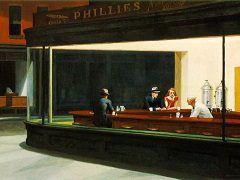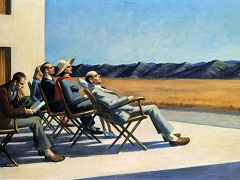Roofs of Washington Square, 1926 by Edward Hopper

In Roofs of Washington Square, the sunlight captures the viewer's eye and invests the objects with their visual power. The transparent, evocative lighting underscores the concrete reality of
the chimneys; it transforms the roof into a bright stage on which the red-colored forms and their dark shadows are cast.
The roof, chimneys, and windows are not objects for human shelter but are simply forms built according to the laws of spacial harmony and coloring. The painting, however, does not exclude man, but
rather assigns him the role of observer. The rows of chimneys face the viewer and, by including him, urge him to perceive their purely physical presence. Only such an "absolute" way of perceiving,
which transcends appearances and does not categorize objects according to their usefulness, can reveal their true significance.
In this watercolor Hopper developed his "art of seeing," which was to become central to his entire work. The photographer Joel Meyerowitz explained what Hopper meant: "I learned that there was
power to be found in the most ordinary things if you knew how to look at them. The way to look at them, Hopper was showing me, was hard: 'Look to the point of fascination,' he seemed to say, don't
turn away. Trust that if you stand long enough to lose yourself you'll see something. And if you learned how to wait, things . . .would slowly seep into your mind and acquire a gravity, a
significance that could be measured with paint and feeling.'"















